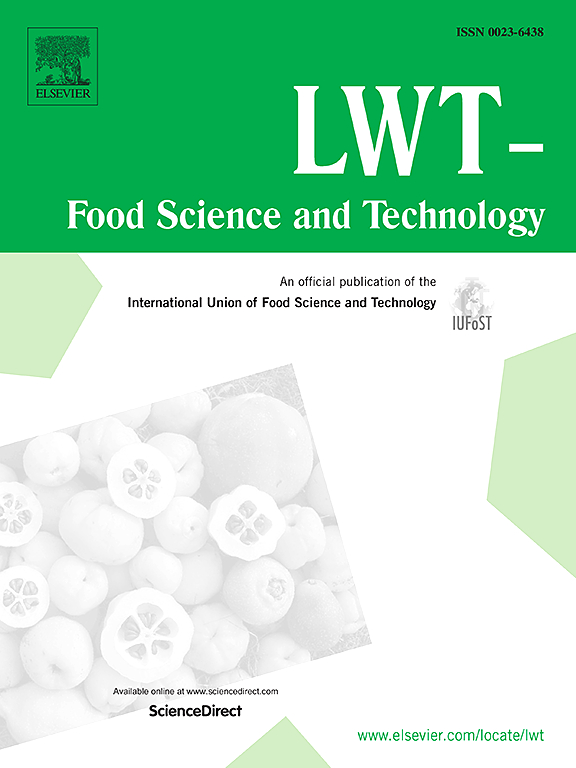利用高通量测序结合非靶向代谢组学研究冷藏大菱鲆(Scophthalmus maximus)的腐败机制
IF 6.6
1区 农林科学
Q1 FOOD SCIENCE & TECHNOLOGY
引用次数: 0
摘要
大比目鱼在冷藏过程中容易变质;然而,在冷藏大比目鱼中腐败微生物及其代谢途径之间的相互作用尚不清楚。阐明这种关系有助于为大比目鱼的保护提供更有效的策略。本研究探讨了冷藏大比目鱼保鲜指标的变化,包括微生物种群和化学指标。采用16S rRNA测序和非靶向代谢组学对冷藏大比目鱼的微生物群落和代谢物进行了分析。结果表明,冷藏大比目鱼的新鲜度随着贮藏时间的延长而下降,并伴有鱼体发黄。代谢组学结果表明,在大菱鲆贮藏过程中存在1159种显著差异代谢物。代谢途径富集表明,参与鱼类降解过程的嘌呤代谢、氨基酸代谢和生物合成以及戊糖磷酸途径是大菱鲆的主要腐败机制。鉴定出8种潜在的腐败生物标志物,其中次黄嘌呤、黄嘌呤、tyrl - leu、Phe-Asn、Gly-L-Phe和L-Ala-L-Trp与冷藏大菱鲆的优势腐败微生物希瓦氏菌、不动杆菌和Brochothrix呈显著正相关。l -谷氨酰胺和PC(20:5(5Z,8Z,11Z,14Z,16E))与冻干杆菌丰度呈负相关。这些鉴定的生物标记物可以为水产品防腐剂的开发提供精确的靶点。本文章由计算机程序翻译,如有差异,请以英文原文为准。

Understanding the spoilage mechanism of refrigerated turbot (Scophthalmus maximus) using high-throughput sequencing combined with untargeted metabolomics
Turbot is susceptible to spoilage during cold storage; however, the interaction between spoilage microorganisms and their metabolic pathway in refrigerated turbot remains unclear. Elucidating this relationship can help provide more effective strategies for the preservation of turbot. This study explored the changes in freshness indexes of refrigerated turbot, including microbial population and chemical indicators. The microbial community and metabolites in refrigerated turbot were analyzed using 16S rRNA sequencing and untargeted metabolomics. Results showed that the freshness of refrigerated turbot declined as the storage period extended, accompanied by yellowing of the fish. Metabolomic results identified 1159 significant differential metabolites during the storage of turbot. Metabolic pathway enrichment illustrated that purine metabolism, amino acid metabolism and biosynthesis, and pentose phosphate pathways, which are involved in the degradation process of fish, were the primary spoilage mechanisms of turbot. Eight potential spoilage biomarkers were identified, among which hypoxanthine, xanthine, Tyr-Leu, Phe-Asn, Gly-L-Phe, and L-Ala-L-Trp exhibited a significantly positive relationship with Shewanella, Acinetobacter, and Brochothrix, which were the dominant spoilage organisms in refrigerated turbot. Furthermore, L-glutamine and PC(20:5(5Z,8Z,11Z,14Z,16E)) exhibited a negative relationship with the abundance of Psychrobacter. These identified biomarkers can provide precise targets for the development of preservatives for aquatic products.
求助全文
通过发布文献求助,成功后即可免费获取论文全文。
去求助
来源期刊

LWT - Food Science and Technology
工程技术-食品科技
CiteScore
11.80
自引率
6.70%
发文量
1724
审稿时长
65 days
期刊介绍:
LWT - Food Science and Technology is an international journal that publishes innovative papers in the fields of food chemistry, biochemistry, microbiology, technology and nutrition. The work described should be innovative either in the approach or in the methods used. The significance of the results either for the science community or for the food industry must also be specified. Contributions written in English are welcomed in the form of review articles, short reviews, research papers, and research notes. Papers featuring animal trials and cell cultures are outside the scope of the journal and will not be considered for publication.
 求助内容:
求助内容: 应助结果提醒方式:
应助结果提醒方式:


